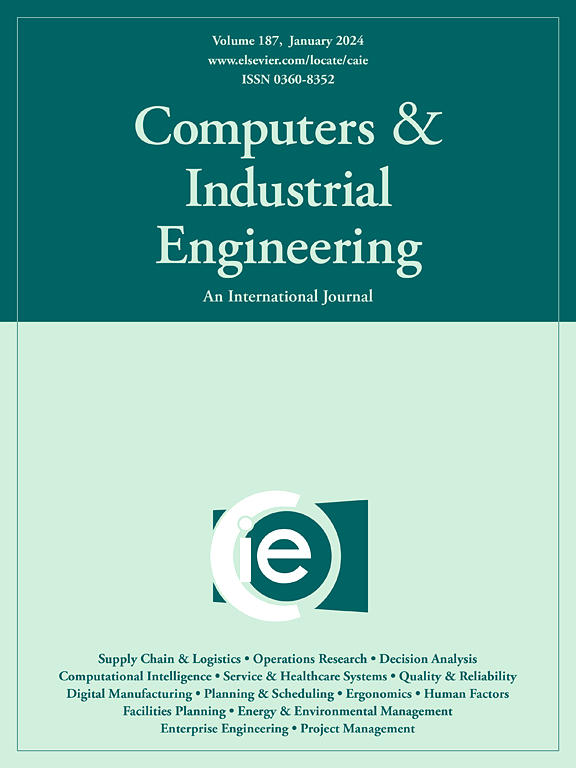A synchronous crew scheduling problem with time fairness based on a two-phrase assignment strategy in an urban rail transit network
IF 6.7
1区 工程技术
Q1 COMPUTER SCIENCE, INTERDISCIPLINARY APPLICATIONS
引用次数: 0
Abstract
Crew scheduling problem (CSP), which involves finding the optimal match between crew members and scheduling tasks, is of utmost importance for completing all train runs within a workday in an urban rail transit (URT) system. Given the variations in train runs, crew compositions, and pooled-station sets across different operational lines, companies that only consider the CSP within a single line may inadvertently cause a significant disparity in working-time fairness among crews, even if they are part of the same organization. To address these concerns, this paper initially proposes an Integer Linear Programming (ILP) model that simultaneously optimizes the two phases of task assignment and task generation, aiming to solve a synchronous crew scheduling problem (SCSP) for the URT network, with a focus on the time fairness of each crew member. Generally, ILP is a set-partitioning-based model with decision variables set to assign tasks. To solve this model, a modified Column Generation (CG) algorithm has been redesigned to generate an optimal solution. Finally, a real-life instance from Beijing is introduced to evaluate the effectiveness of the proposed method. The results demonstrate that the cross-line scheduling plan (CLSP) based on the URT network can conserve crew resources by 4.73 % (reducing 13 crews) and shorten the average working time by up to 3.48 min. compared to the single-line scheduling plan (SLSP). Moreover, the CLSP manages to keep the working time fluctuations for each crew within an acceptable range of [0 min, 8 min]. This indicates that CLSP in the URT network is effective in meeting the fairness requirements for crews.
基于两阶段分配策略的城市轨道交通网络中具有时间公平性的同步机组调度问题
班组调度问题(CSP)是城市轨道交通系统在一个工作日内完成所有列车运行的关键问题,它涉及到机组人员与调度任务之间的最优匹配问题。考虑到不同运营线路的列车运行、机组人员组成和合集站点设置的差异,只考虑单线内CSP的公司可能会在不经意间造成机组人员工作时间公平性的显著差异,即使他们是同一组织的一部分。为了解决这些问题,本文初步提出了一个整数线性规划(ILP)模型,该模型同时优化任务分配和任务生成两个阶段,旨在解决轨道交通网络的同步机组调度问题(SCSP),重点关注每个机组成员的时间公平性。一般来说,ILP是一个基于集合划分的模型,它设置决策变量来分配任务。为了求解该模型,重新设计了一种改进的列生成(CG)算法,以生成最优解。最后,以北京的一个实例对所提方法的有效性进行了评价。结果表明,基于轨道交通网络的跨线调度方案(CLSP)与单线调度方案(SLSP)相比,可节约机组资源4.73%(减少13名机组人员),缩短平均工作时间3.48 min。此外,CLSP设法将每个乘员的工作时间波动保持在可接受的范围内[0分钟,8分钟]。这表明,轨道交通网络中的CLSP能够有效地满足机组人员的公平性要求。
本文章由计算机程序翻译,如有差异,请以英文原文为准。
求助全文
约1分钟内获得全文
求助全文
来源期刊

Computers & Industrial Engineering
工程技术-工程:工业
CiteScore
12.70
自引率
12.70%
发文量
794
审稿时长
10.6 months
期刊介绍:
Computers & Industrial Engineering (CAIE) is dedicated to researchers, educators, and practitioners in industrial engineering and related fields. Pioneering the integration of computers in research, education, and practice, industrial engineering has evolved to make computers and electronic communication integral to its domain. CAIE publishes original contributions focusing on the development of novel computerized methodologies to address industrial engineering problems. It also highlights the applications of these methodologies to issues within the broader industrial engineering and associated communities. The journal actively encourages submissions that push the boundaries of fundamental theories and concepts in industrial engineering techniques.
 求助内容:
求助内容: 应助结果提醒方式:
应助结果提醒方式:


